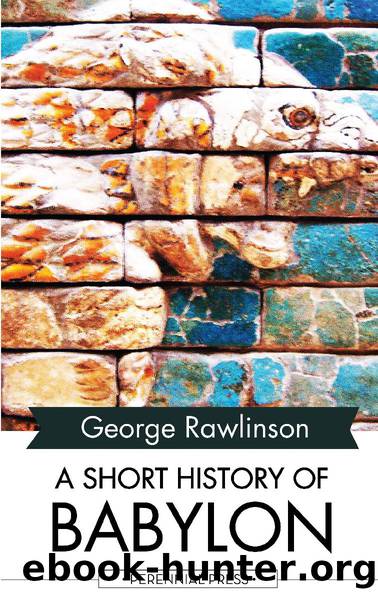A Short History of Babylon by George Rawlinson

Author:George Rawlinson
Language: eng
Format: epub
MANNERS AND CUSTOMS.
“GIRDED WITH GIRDLES UPON their loins, exceeding in dyed attire upon their heads, all of them princes to look to, after the manner of the Babylonians of Chaldaea, the land of their nativity."—Ezek. xxiii. 15.
The manners and customs of the Babylonians, though not admitting of that copious illustration from ancient monuments which was found possible in the case of Assyria, are yet sufficiently known to us, either from the extant remains or from the accounts of ancient writers of authority, to furnish materials for a short chapter. Herodotus, Strabo, Diodorus, and Nicolas of Damascus, present us with many interesting traits of this somewhat singular people; the sacred writers contemporary with the acme of the nation add numerous touches; while the remains, though scanty, put distinctly and vividly before our eyes a certain number of curious details.
Herodotus describes with some elaboration the costume of the Babylonians in his day. He tells us that they wore a long linen gown reaching down to their feet, a woollen gown or tunic above this, a short cloak or cape of a white color, and shoes like those of the Boeotians. Their hair they allowed to grow long, but confined it by a head-band or a turban; and they always carried a walking-stick with a carving of some kind on the handle. This portraiture, it is probable, applies to the richer inhabitants of the capital, and represents the Babylonian gentleman of the fifth century before our era, as he made his appearance in the streets of the metropolis.
The cylinders seem to show that the ordinary Babylonian dress was less complicated. The worshipper who brings an offering to a god is frequently represented with a bare head, and wears apparently but one garment, a tunic generally ornamented with a diagonal fringe, and reaching from the shoulder to a little above the knee. The tunic is confined round the waist by a belt. Richer worshippers, who commonly present a goat, have a fillet or headband, not a turban, round the head. They wear generally the same sort of tunic as the others; but over it they have a long robe, shaped like a modern dressing-gown, except that it has no sleeves, and does not cover the right shoulder. In a few instances only we see underneath this open gown a long inner dress or robe, such as that described by Herodotus. A cape or tippet of the kind which he describes is worn sometimes by a god, but is never seen, it is believed, in any representation of a mortal.
The short tunic, worn by the poorer worshippers, is seen also in a representation (hereafter to be given) of hunters attacking a lion. A similar garment is worn by the man—probably a slave—who accompanies the dog, supposed to represent an Indian hound; and also by a warrior, who appears on one of the cylinders conducting six foreign captives. There is consequently much reason to believe that such a tunic formed the ordinary costume of the common people, as it does at present of the common Arab inhabitants of the country.
Download
This site does not store any files on its server. We only index and link to content provided by other sites. Please contact the content providers to delete copyright contents if any and email us, we'll remove relevant links or contents immediately.
| Africa | Americas |
| Arctic & Antarctica | Asia |
| Australia & Oceania | Europe |
| Middle East | Russia |
| United States | World |
| Ancient Civilizations | Military |
| Historical Study & Educational Resources |
Empire of the Sikhs by Patwant Singh(22763)
The Wind in My Hair by Masih Alinejad(4839)
The Templars by Dan Jones(4557)
Rise and Kill First by Ronen Bergman(4544)
The Rape of Nanking by Iris Chang(4022)
12 Strong by Doug Stanton(3419)
Blood and Sand by Alex Von Tunzelmann(3055)
The History of Jihad: From Muhammad to ISIS by Spencer Robert(2504)
Babylon's Ark by Lawrence Anthony(2427)
The Turkish Psychedelic Explosion by Daniel Spicer(2245)
No Room for Small Dreams by Shimon Peres(2235)
Gideon's Spies: The Secret History of the Mossad by Gordon Thomas(2231)
Inside the Middle East by Avi Melamed(2230)
Arabs by Eugene Rogan(2193)
The First Muslim The Story of Muhammad by Lesley Hazleton(2153)
Bus on Jaffa Road by Mike Kelly(2035)
Come, Tell Me How You Live by Mallowan Agatha Christie(2024)
Kabul 1841-42: Battle Story by Edmund Yorke(1921)
1453 by Roger Crowley(1879)
